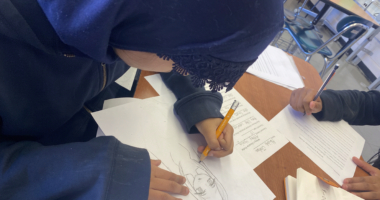Joining the Teaching Artist Project’s collaborative art-making track with Adriana Guzman and my fieldwork team, brought to my attention how unfocused my approach to community-based art education was. As an art practitioner in the field of community and museums, balancing community building and art-making can be challenging. On one hand, feeling called to lead authentic cultural productions with meaning for the communities involved. On the other, achieving an aesthetic result, with techniques, disciplines, and institutions that have traditionally ignored or under-resourced the communities I serve.
To bring clarity and intentionality to my practice, I decided to use TAP’s blog as a space to share my research parallel to TAP sessions. I hope this research will guide me in my new role in Community Engagement at the Guggenheim Museum, which I owe a great deal to the human connections I made at TAP. The following is a barebones guide for myself and any other community-based art educator based on the “Framework for Successful Community-Art Projects” in the book “Engaging Classrooms and Community through Art”. I’ve tweaked and summarized it to a short format to allow for a digestible and actionable reading.

Krensky, B., & Steffen, S. L. (2009). Engaging classrooms and communities through art: A guide to designing and implementing community-based art education. Rowman Altamira.
My inspiration for sharing this book and summarizing it into this guide was based on one of our community practices “what do I bring to the space?” I hope that making my private concurrent work to TAP visible to other participants is a way to answer that question. I also recommend any art educator to read the full version of the book mentioned above.
Framework for Successful Community-Art Projects:
- Go beyond a conception of art as a medium for self-expression/self-definition, or socializing appropriate norms/qualities in students. And, embrace a transformative framework. Reflect on the notion that the development of the imagination is the impetus for social change. Some forms of transformative artworks approaches are public art, activist art, and community art-making.
- When working in classrooms, work on fulfilling curriculum-based goals by connecting students to larger issues pertinent to the school’s community context. This will foster social responsibility and civic participation.
- Conduct profound research about the community. Learn the key streets, landmarks, commercial establishments, political members, demography, culture, idiosyncrasy, particular issues, and contributions.
- Identify basic, inherent project goals as a starting point or platform for community participants to co-create additional goals. The forthcoming dialogue will foster an authentic participatory process that will refine the final goals of the planning process.
- Consider a communication strategy to keep everyone informed, engaged and foster confidence about the outcome to the parties involved. Community gatekeepers, participant members, government, and funders will always appreciate being on the same page. I suggest weekly updates.
- Secure adequate funding and legal counseling. Particularly when working in public spaces, seek legal counsel to establish agreements and understand liabilities.
- Establish a safe and fun environment by creating agreed-upon community norms with program participants in the first session. For safety, some norms are to respect each other, authentic participation, and active listening. For fun, planning the input of the session to fuel creativity through artistic prompts as a way to organize the creative flow.
- Determine the audience of the final artwork. Although sometimes determined by funders, and community participants, take the time to identify the public-facing aspect of the artwork. Effective art practitioners encourage participants to make art that means something to them and others as well. For example, the core community group can make a survey to the larger community on what they would like to have, see, or experience.
- Envision the content and form of the collaborative artwork by inspiring and authorizing participants to explore and expand their conception of what is possible thematically, technically, and aesthetically. This can happen through brainstorming sessions, and arts-based exercises such as drawing, creating collages, photography, and computer-generated graphics.
- Provide technical and logistical support with comprehensive artistic training so community members can express their vision. This involves mentorship, studio classes, art history classes, meeting with artists, use of professional art materials, among others. Once rigorous training is provided, treat them as colleagues to encourage them to see themselves as capable artists with responsibilities in the project.
- Host a formal unveiling and celebration for others to witness. Community artworks are complete with the viewer’s experience. A community art-based project can’t be considered complete until there has been some change in the physical landscape of the community. A celebration for the core group could be hosted after the unveiling or on a different day.
- Reflect and evaluate the experience of participants to provide a sense of completion. Also, it will inform the quality of future projects which is important since this is both a process or a product.
As much as we wish to be product-oriented, listening to our hearts and trusting the process of ourselves and others is as important. Certain projects might not come to fruition for circumstances out of our control. For that reason, I would like to reflect on the teachings of a life mentor who guided me into joining TAP, Jen Dayton. A mindfulness and dance educator, Yogui, and a beautiful soul, by using the following quote:
An Artist has not always to finish his work…so he may succeed in making the spectator his co-worker. -Havelock Ellis, The Dance of Life
Additional Resources

Sommer, D. (2013). The work of art in the world: Civic agency and public humanities. Duke University Press.



